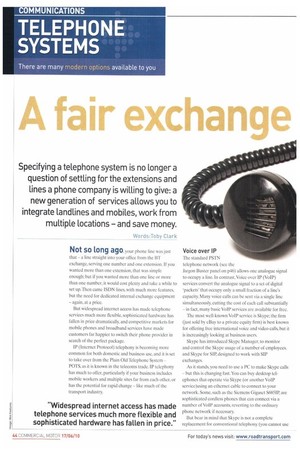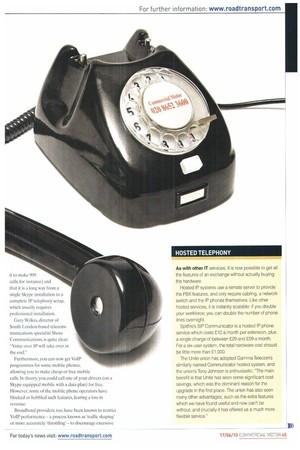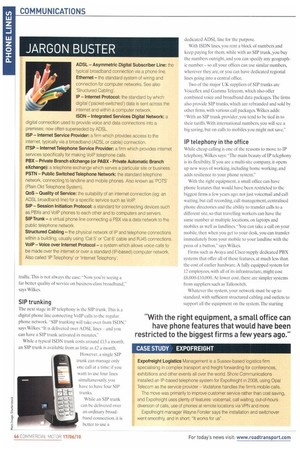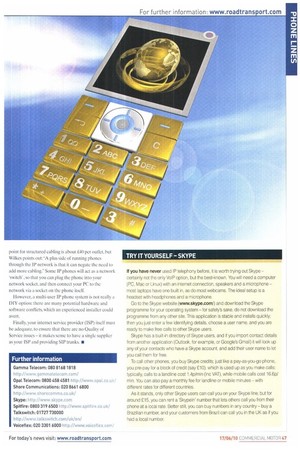eAt.i
Page 44

Page 45

Page 46

Page 47

If you've noticed an error in this article please click here to report it so we can fix it.
Specifying a telephone system is no longer a question of settling for the extensions and lines a phone company is willing to give: a new generation of services allows you to integrate landlines and mobiles, work from multiple locations and save money.
Aoras:TOby Clark Not so Long ago. your phone line was just that — a line straight into your office from the BT exchange, serving one number and one extension. If you wanted more than one extension, that was simple enough; but if you wanted more than one line or more than one number, it would cost plenty and take a while to set up. Then came ISDN lines, with much more features, but the need for dedicated internal exchange equipment — again, at a price.
But widespread internet access has made telephone services much more flexible, sophisticated hardware has fallen in price dramatically, and competitive markets for mobile phones and broadband services have made customers far happier to switch their phone provider in search of the perfect package.
IP (Internet Protocol) telephony is becoming more common for both domestic and business use, and it is set to take over from the Plain Old Telephone System — POTS, as it is known in the telecoms trade. IP telephony has much to offer, particularly if your business includes mobile workers and multiple sites far from each other, or has the potential for rapid change — like much of the transport industry.
Voice over IP
The standard PSTN telephone network (see the Jargon Buster panel on p46) allows one analogue signal to occupy a line. In contrast, Voice over IP (VoIP) services convert the analogue signal to a set of digital 'packets' that occupy only a small fraction of a line's capacity. Many voice calls can be sent via a single line simultaneously, cutting the cost of each call substantially — in fact, many basic VoIP services are available for free.
The most well-known VoIP service is Skype; the firm (just sold by eBay to a private equity firm) is best known for offering free international voice and video calls, but it is increasingly looking at business users.
Skype has introduced Skype Manager, to monitor and control the Skype usage of a number of employees, and Skype for SIP, designed to work with SIP exchanges.
As it stands, you need to use a PC to make Skype calls — but this is changing fast. You can buy desktop telephones that operate via Skype (or another VoIP service)using an ethernet cable to connect to your network. Some, such as the Siemens Gigaset S6851P, are sophisticated cordless phones that can connect via a number of VoIP accounts, reverting to the ordinary phone network if necessary.
But bear in mind that Skype is not a complete replacement for conventional telephony (you cannot use it to make 999 calls, for instance) and that it is a long way from a single Skype installation to a complete IP telephony setup, which usually requires professional installation.
Gary Wilkes. director of South London-based telecommunications specialist Shore Communications, is quite clear: "Voice over W will take over in the end."
Furthermore, you can now get VolP programmes for some mobile phones, allowing you to make cheap or free mobile calls. In theory, you could call one of your drivers (on a Skype-equipped mobile with a data plan) for free. However, some of the mobile phone operators have blocked or hobbled such features, fearing a loss in revenue.
Broadband providers. too, have been known to restrict VoIP performance — a process known as 'traffic shaping' or more accurately 'throttling' — to discourage excessive traffie.This is not always the case: Now you're seeing a far better quality of service on business-class broadband," says Wilkes.
SIP trunking The next stage in IP telephony is the SIP trunk. This is a digital phone line connecting VolP calls to the regular phone network. "SIP trunking will take over from ISDN," says Wilkes. "It is delivered over ADSL lines and you can have a SIP trunk activated in minutes.
While a typical ISDN trunk costs around £13 a month, an SIP trunk is available from as little as £2 a month.
However, a single SIP trunk can manage only one call at a time: if you want to use four lines simultaneously, you have to have four SIP trunks.
While an SIP trunk c. can be delivered over an ordinary broadband connection, it is better to use a dedicated ADSL line for the purpose.
With ISDN lines, you rent a block of numbers and keep paying for them, while with an SIP trunk, you buy the numbers outright, and you can specify any geographic number so all your offices can use similar numbers, wherever they are, or you can have dedicated regional lines going into a central office.
Two of the major UK suppliers of SIP trunks are Voiceflex and Gamma Telecom, which also offer combined voice and broadband data packages. The firms also provide SIP trunks, which are rebranded and sold by other firms. with various call packages. Wilkes adds: -With an SIP trunk provider, you tend to be tied in to their tariffs. With international numbers, you will see a big saving, but on calls to mobiles you might not save.
IP telephony in the office
While cheap calling is one of the reasons to move to IP telephony, Wilkes says: "The main beauty of IP telephony is its flexibility. If you are a multi-site company, it opens up new ways of working, including home working, and adds resilience to your phone system."
With the right equipment, a small office can have phone features that would have been restricted to the biggest firms a few years ago: not just voicemail and call waiting, but call recording, call management, centralised phone directories and the ability to transfer calls to a different site, so that travelling workers can have the same number at multiple locations, on laptops and mobiles as well as landlines. "You can take a call on your mobile, then when you get to your desk, you can transfer immediately from your mobile to your landline with the press of a button," says Wilkes.
Firms such as Avaya and Cisco supply dedicated PBX systems that offer all of these features, at much less than the cost of earlier hardware. A fully equipped system for 12 employees, with all of its infrastructure, might cost £8,000-£10,000. At lower cost, there are simpler systems from suppliers such as Talkswitch.
Whatever the system, your network must be up to standard, with sufficient structured cabling and outlets to support all the equipment on the system.The starting point for structured cabling is about izIO per outlet, hut Wilkes points out: "A plus side of running phones through the IP network is that it can negate the need to add more cabling." Some IP phones will act as a network 'switch' , so that you can plug the phone into your network socket, and then connect your PC to the network via a socket on the phone itself.
However, a multi-user IF phone system is not really a DIY option: there are many potential hardware and software conflicts, which an experienced installer could avert.
Finally, your internet service provider (ISP) itself must be adequate, to ensure that there are no Quality of Service issues — it makes sense to have a single supplier as your 1SP and providing SIP trunks, •
































































































































